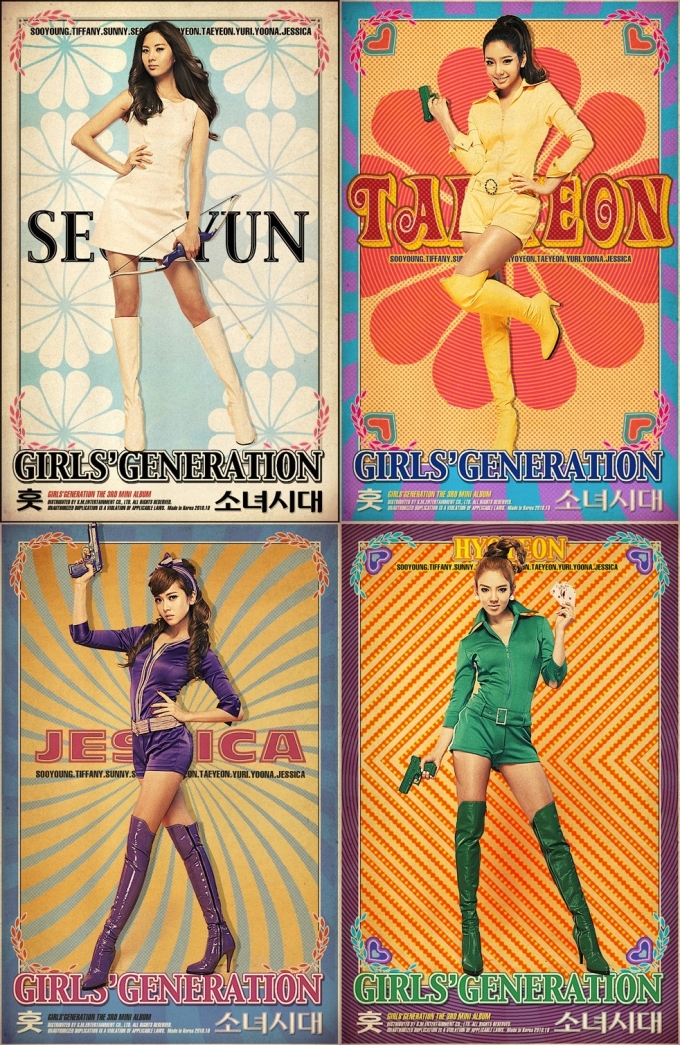 (Source)
(Source)
Despite everything I’ve said about Girls’ Generation (소녀시대) over the years, I’m really liking this retro look for their new mini-album Hoot (훗), to be released later this week. Heck, along with Eccentric Yoruba, I’m even liking the title track too, whereas I needed to hear DJ Areia’s trance remix before I could even begin to listen to Oh! (오!).
But I’ve actually liked Korean retro itself for a long time now, and the posters reminded me of a brief article on that from the November 2008 edition of Design Journal (디자인저널), which I thought readers may also be interested in. And in the magazine itself of course, which — although its English could be much improved as you’ll soon see — is very rare in that it has both English and Korean versions of each article, helping to open up an entire creative side of Korean life that would normally be relatively inaccessible to expats.
 Alas, unfortunately I’ve just learned that there were no more issues published after July 2009. But I do hope you still enjoy the article though, and if so then you may also like the So Much Pileup blog that I subscribe to, which has examples of retro graphic design from around the world. Personally, I was hooked on it as soon as I read the following about the logotype on the right:
Alas, unfortunately I’ve just learned that there were no more issues published after July 2009. But I do hope you still enjoy the article though, and if so then you may also like the So Much Pileup blog that I subscribe to, which has examples of retro graphic design from around the world. Personally, I was hooked on it as soon as I read the following about the logotype on the right:
The way that A and the S form together as one. It’s like they’re having an incredibly intimate moment that I happened to stumble upon. Where as the r-a ligature seems a little forced. That lowercase a will undoubtedly wake up feeling used and perhaps will regret the whole experience.
And in that same spirit of turning what was once considered dull and ordinary into something fun and sexy, let me leave you with all the great examples of Korean retro mentioned below:
Any other aficionados out there?^^
Update: More retro-themed pictures of Girls’ Generation are available here:
Update 2, July 2012: Here’s a post on the “fashion police” of the 1970s who would check women’s skirt lengths, which emerged in the discussion in the comments.


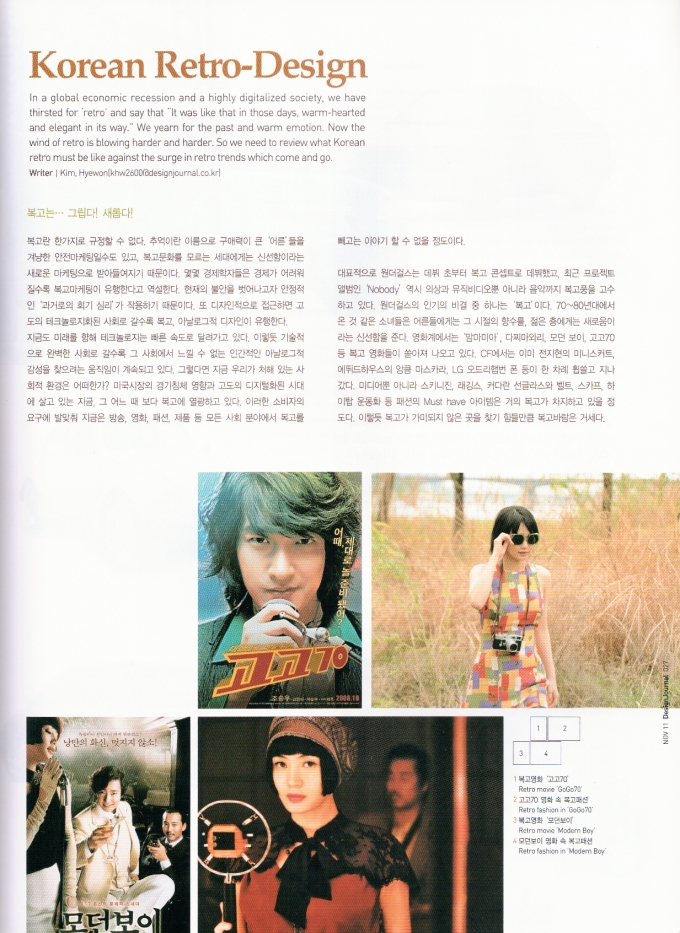
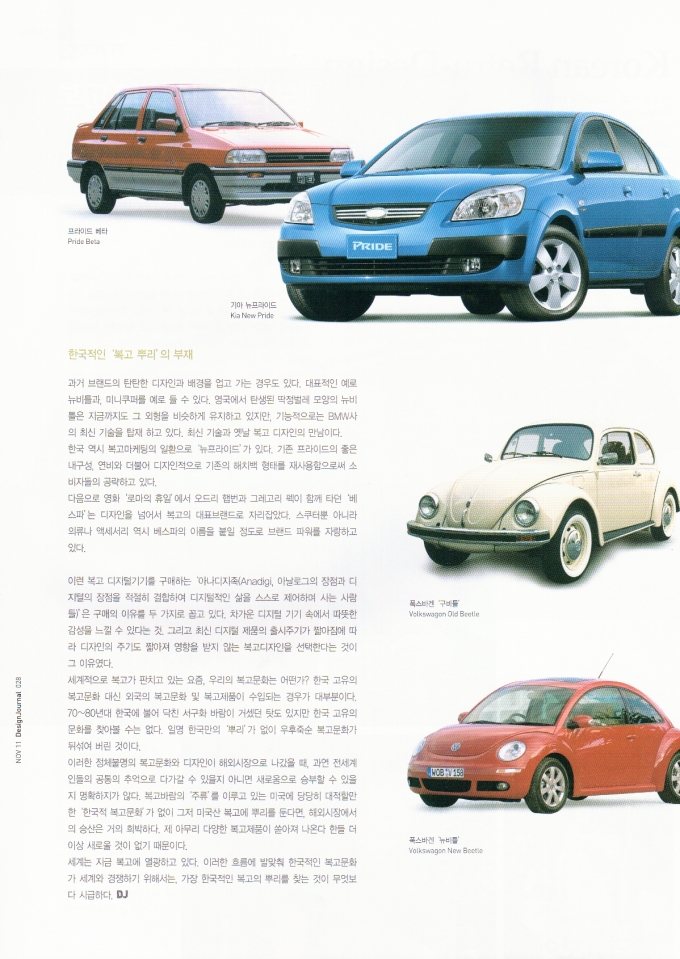
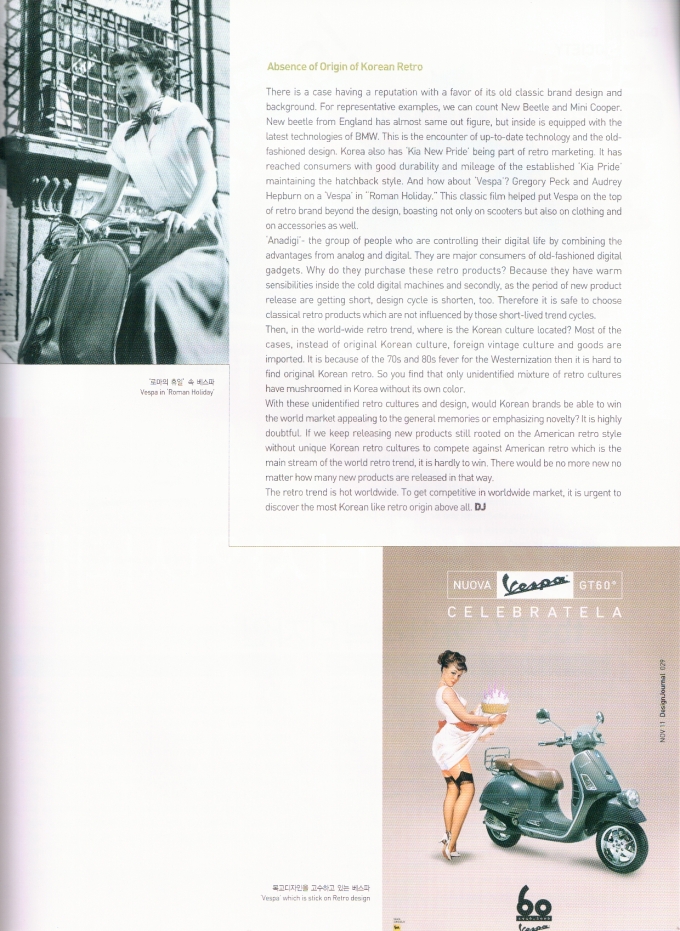
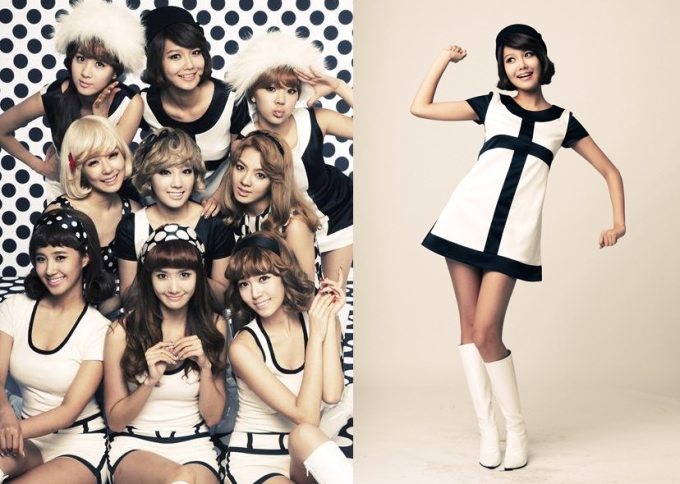

Retro is way overdone in the US, and has been for about a decade. But it’s interesting to see it here in a Korean setting, even if it is pretty much just limited to an Austin Powers theme.
LikeLike
Well, I rather hope it goes beyond the Austin Powers (I still think more Bond girl) stage, although Girls’ Generation will undoubtedly generate a great deal of interest in it.
As I type this I’m realizing there’s a curious parallel between the effects of Korea’s fever for Western goods in the 70’s and 80’s as mentioned in the article (although I think exaggerated), and Australia and New Zealand’s similar excessive importation of UK goods (and cultural cringe towards the UK) in the 50’s and 60’s. Because like Clive James mentioned in I think his 2nd autobiography Falling Towards England (1985), especially young Australians transplanted to England like himself began to realize the distinctiveness of their Australiana (Kiwiana in NZ) to consumer products and so on in England itself and their own shared knowledge of them, which seriously began to plant the notion in Australian people’s minds (most ultimately returned of course) that no, Australia wasn’t really a transplanted England (an enduring symbol of which was hot Christmas dinners in 50C heat in the desert).
Not that Koreans lack a sense of nationalism of course, but then I’m sure I don’t need to explain to you(!) that all too many of them seem to have almost a palpable distaste for things that are genuinely and uniquely Korean, instead constantly presenting things to the outside world that are neither, but which they nevertheless think non-Koreans would prefer. If they had a greater sense of Koreana via an new interest in – the probably quite large amount of – the Korean retro out there however, then I think that would be an important step in beginning to appreciate their own culture more.
Sorry if all that last sounds cheesy though: will wisely go to bed now!
LikeLike
I’m writing a paper on this very subject right now, along the lines of retro vs ‘authentic’ nostalgia. Thanks very much for providing this article – the timing is quite fortuitous!
LikeLike
You’re welcome! And seeing as you’re an expert(!), any thoughts yourself on my long reply to Brian?^^
LikeLike
I’m a bit mystified by the comment about a ‘fever for Western goods in the 70s/80s’. If such a phenomenon existed, it was not a fever for actual Western goods but for Korean imitations. Western goods simply weren’t imported into Korea in large numbers in the 70s and 80s. What Korea did do, however, (and still do) was to produce countless slavish imitations of Western brands under which they marketed domestically produced products.
There was a very interesting exhibition a couple of years ago at the art centre near Nambu terminal called 50 Years of Korean Graphic Design that documented hundreds of logos of such imitation brands, many of which would vary the name of the brand by one letter (Puma to Pima, for example), and then use the same colour scheme and graphics. And what was also striking about this exhibition was how radically different Korean-produced Korean-style graphic design was at that time, especially newspapers, which would be unrecognisable as such today.
I will say a little more later, but right now, I have to get to work.
LikeLike
Thanks for adding that, and yes: I was a little surprised at that too, especially considering the consumption of Korean-produced consumer goods was explicitly conflated with national security in the the 1960s and (especially) the 1970s.
I would say more sorry, but everything’s already been covered by other commenters really!
LikeLike
Retro is still big in the US….although it’s not so much 60’s and 70’s (Mad Men is helping a bit) But the hot retro right now is 90’s. The mismatched bright colors and grunge! is back. I wouldn’t say Grunge design is back (thank god), but there is a 90’s feel to the popular color schemes and DYI’iness to everything. <— my opinion as someone who teaches motion design. This "Korean Retro" as you called it feels too studied to me, so it comes off as forced. As many concepts idol bands try. Especially when girl idols do a "sexy" concept. It always comes of as unnatural b/c it has that studied air and pretension to it. I know you're lovin it…but i still see this new concept as kind forced.
LikeLike
I’m no expert, but just casual glances at MTV/VH1, pop culture, and the teenagers I know makes me think of the 80s being in, rather than the 90s.
(Mad Men is one of my favorite shows, and I’m glad to see them get the early 60s right)
I wonder what it would take for a greater appreciation of Korea’s own “retro,” and the music of the 60s. It might be, and this is something I noticed when looking at the “7080” festival in Gwangju each fall, that there’s really not too much authentic retro stuff there because, unlike for Americans, the 50s, 60s, 70s, and 80s weren’t really the “good old days” for Koreans who grew up during war, poverty, and repressive governments. Maybe that’s why SNSD is looking elsewhere for their image of retro, filtered through other pop culture sources (including Kim Yuna).
I wonder too, James, and this is tangential, if there will be any kick up about the use of guns in the pictures, seeing how in spite of mandatory conscription for men and the threat of North Korea, guns are almost entirely absent from South Korean society (save for the guards at Incheon Airport).
LikeLike
“unlike for Americans, the 50s, 60s, 70s, and 80s weren’t really the “good old days” for Koreans who grew up during war, poverty, and repressive governments.”
I still think it would be more interesting and authentic if they pulled their retro looks from their own history. By pulling from West, I still argue that it feels forced. And, the 50’s, 60, 70’s ect…are not exactly the “good old days.” The thing about retro and nostalgia is only remembering the positive and highlighting that. A good/positive image can be pulled from everything. Designer have found nostalgia from communist design. My students still reference that time period and draw from it. I just think retro would work better in Korea if it was their retro.
LikeLike
You and Buki beat me to it. Korean retro is an imitation of American retro. In the 60s, Korean women did not wear minis, hotpants, and thigh-high go-go boots, and they weren’t 170 cm tall with endless legs. There is something disturbing about dressing Korean girls up in Western 60s clothes and then photoshopping their bodies to Western model proportions.
I was in diapers when thigh-high boots first came into fashion, and I may be too old now, but I bought a pair of black suede ones anyway.
LikeLike
I saw some old Korean movie posters displayed in a subway station in Gwangju a few months ago that showed Korean actresses dressed exactly in this way. It was, of course, in imitation of American culture of the period, but that doesn’t lessen Korea’s ownership of it in terms of the urge to resurrect it. As material conditions very slowly improved in the 60’s and 70’s, a popular consumer culture had to be invented – where better to take your cue than from the country that had more than anyone?
(I’ve tried to find some of these movie posters online but so far have had little luck. Anyone know of any sites?)
LikeLike
I agree . . . Koreans were engaging with western fashion, but what else would they have to draw from? The fashions of the 60’s and 70’s and 80’s that were American culture are also, simultaneously (ok, 5 years behind the trend) Korean fashions of the times.
LikeLike
Korean women in Seoul and other big cities were wearing Western clothes in the 60s, but hot pants and go-go boots? Only in movies. I’ve never seen an old photo of real Korean women in clothes like the ones modeled above. In contrast, real Western women in trendy, liberal cities really did wear that stuff, at least for a night out. Korean “ownership” of that look is minimal at best.
LikeLike
But retro always tends towards the products of culture and not the material of real life.
LikeLike
I’m not sure how to respond because I don’t know what you mean. Do you mean that products of culture are created by media and not by real people in real life? Retro may exaggerate past trends, but it does not manufacture them. Back in the 80s I really had big hair and wore high-waisted pants, and I was living in a small midwestern town, not Manhattan. In the 70s I was Bicentennially fashionable in a pair of red hiphuggers with a white waistband adorned with blue stars. The Jane Fonda Klute shag I sported in my 3rd grade picture still makes me cringe and smile at the same time.
LikeLike
I’m not saying that anything is not created by real people – that would be silly. What I mean is when we nostalge upon a period (‘nostalge’ is a word that I just made up whose intended meaning I hope is simple to discern), we do not slavishly recreate the material conditions of that period but instead intend upon a typically narrow tranche of the cultural production of that period which take to be representative. For instance, when we nostalge upon London in the late 60s, we think of the Rolling Stones and Carnaby Street and Mary Quant and lots of drugs and sex, and tend to forget what a god-awful and thoroughly limited life most people had at that time. Reality was very different to its representations in culture and advertising then as it is now.
LikeLike
If they weren’t wearing them, why were the police checking women’s skirt length and men’s hair length? If the fashions weren’t in, there’s have been little need for the government to attack and regulate the fashions during the Park Chung-hee era, for example. And a quick google search also turned up plenty of photos of women in short skirts, and even a go go boot or two. Also, lots of films from the era portray fashionable younger women wearing a variety of what would have passed for tolerably fashionable clothing in the west. Yes, they may not have been wearing some of this stuff on an everyday basis, but most American and English women weren’t either, as you yourself noted.
LikeLike
What Google search terms did you use? The images I got looked to be more recent. Back in the 60s, any skirt hem above the knee probably got the attention of the police.
LikeLike
I googled 박정희 미니스커트 단속 and on the first several pages of results got many copies of the famous photo of the short young woman in a minidress and knee-length boots getting her hemline measured by a police officer along with what looks like a few fashion shoot photos of women in minis. I googled 미니스커트 핫팬츠 박정희 and found on p.2 of the results one photo of three women in shorts strolling on the street in 1971. Obviously there were some women wearing miniskirts and shorts, or the government wouldnt’ have banned them. I also noticed that the few Korean women photographed in miniskirts and shorts had more traditional body shapes. I did not see a single 1960s-70s image of a Korean woman, not even the fashion models, who looked REMOTELY like the digitally enhanced members of SNSD in the Austin Powers-inspired posters.
On the other hand, I have a tall, very attractive older cousin who graduated from high school in the early 70s. She wore the coolest clothes, bell bottoms and miniskirts, and had gorgeous long hair. Her brother and other male cousins on that side of the famliy epitomized American 70s cool: long hair, polyester shirts half-unbuttoned, and bell bottom jeans and cords. For me, American fashion retro images from the 1960s and 70s aren’t that far removed from what I recall people around me wearing and what I see in old family photos.
LikeLike
I just did a simple 1960년대 한국 and within the first few pages found women in clothing that was very similar to some of the outfits seen here.
And again, even if they weren’t dead ringers for the exact outfits SNSD is wearing, I don’t know what difference it would make. They’re trying to evoke the feel of an era they weren’t even living in (nor likely the stylists and designers who came up with the concept), not re-create it with museum accuracy. Just like 새마을식당 is selling a goofy rendition of the Park era, not expecting people to go experience an authentic recreation of 70’s dining.
LikeLike
You found “plenty of photos of women in short skirts” by using the search terms 1960년대 한국” I just repeated that search and found mostly unrelated the photos. The only image of women on the street wearing clothing with hemlines above the knee was on p. 3: http://kr.blog.yahoo.com/navigur/folder/2379878.html P.1 has a larger cropped image of the same women. I wonder where those “plenty of photos” disappeared to in the last two days.
The SNSD weren’t evoking a bygone era of Korean fashion. The whole composition from background flower power to hot pants to Heather Grahamish endless legs to the pistols, the new SNSD minialbum cover was inspired by Austin Powers, not Park Chung-hee Korea. Austin Powers was very cool, but it ain’t Korean retro.
LikeLike
While the first one to grab my attention, it certainly wasn’t the only one. And the first few pages feature lots of women who are not in go-go boots and minis, but are certainly in recognizably 1960’s western-style clothing that wouldn’t be the least bit out of fashion in our current “retro” mood – either stateside or here in Korea. Record album covers and movie posters from the period also show women in such clothes, and even some remarkably similar outfits. See here: http://dorothy01.egloos.com/tag/%EC%9D%8C%EC%95%85/page/2 and http://miniurl.com/63764
LikeLike
@Stevie B
Try Seen in Jeonju perhaps, which has a lot of Korean movie posters on it.
LikeLike
@sonagi
Hey, sorry, just need to drop a douchebomb in here.
Is it any less disturbing when Western models photoshop their bodies to so-called Western model proportions? Or just different?
http://poponthepop.com/2010/04/britney-spears-cellulite-picture-before-and-after-photoshop-ad-r/
Google has plenty of before/after photoshop images out there for Western models.
Glad you said Western *model* proportions though. Tired of hearing people make the same ridiculous argument about Koreans trying to look like Western women.
A quick look on the internet reveals that, according to the CDC (1999-2002), the average American woman is:
Height (inches): 63.8
Weight (pounds): 164.7
Waist circumference (inches): 37.0
That’s what Korean women want to be? Huh? Has the Western world (or expat blogosphere at least) completely lost touch with what real Western women look like? The Western standard of beauty is NOT inhabited by the Western woman. So what is it and where does it come from?
Instead of asking: What’s up with Korean women wanting to look like Western models?
We could ask: What’s up with women (Korean AND Western) wanting to look like things that don’t exist? Where do these things come from? What the hell are they? Yeah, these questions sound easy, but…
I understand that cross-cultural issues are the focus of this blog, but it’s counter-productive to force a reading through such a restricted lens. A more interdisciplinary approach (or just widening the scope) could allow for a more informed and comprehensive understanding of these issues.
TL;DR: It might be time to look beyond the so-oft-repeated-it’s-become-truth of Koreans-wanna-be-white-and-white-people-pat-them-on-the-head-and-say-no-no-that’s-not-for-you thing.
This self-serving delusion only gets us so far.
LikeLike
Actually, truemoboy, this is one rare occasion where I tend to agree with you. Photoshopping perfectly normal, attractive bodies to extremes occurs in the US media, too. The Western standard of beauty is not inhabited by the typical Western woman, but it is embodied by popular supermodels, who are a little curvier than the straight-boned high fashion models.
LikeLike
@Sonagi Sorry, I’m confused: were you specifically referring to the SNSD posters above in your comment, or just talking generally?
Either way, it reminded me of this commercial with Jun Ji-hyun from 2007:
I quite like it to be honest, but then it is a commercial and not a photoshopped ad of course!
LikeLike
@Brian The tangent is fine of course(!), but I seriously doubt there’ll be any fuss at all the use of the guns. Even if it wasn’t hugely popular SNSD too (unless someone with an eye for news like yourself can think of any past complaints?)
By coincidence, I’ve also been finding young Korea guy’s hairstyles at least being strongly reminiscent of those from the 1980s or even late-1970s. Add in a very recent trend among both sexes for huge square-rim glasses too, and it’s really quite eerie the way they look sometimes.
LikeLike
I’m not sure what this will add to the discussion but I’ve had these saved in my favorites due to it faithfully recreating the 80’s that I don’t think existed in Korea. It doesn’t even attempt to re-imagine the 80’s. It looks like it was made in the 80’s played through a chewed up VCR tape but with korean artists.
EE:
I don’t know too much about past Korean music that’s unique to Korea except for a few old folk tunes. Would love to see a modern take on them. There was trot and it seems that was around for a long stretch based on the volume of videos I’ve spotted on youtube. Plenty of more modern folk and ballads in the 80’s.
I think Brian is right in why SNSD is looking else where for their retro image and frankly, retro Korea isn’t sexy. I get the feeling It’s more introspective and sometimes quite depressing. It wouldn’t sell.
LikeLike
Thanks for passing them on, and that’s a good way to sum them up. And sorry to overuse the term in this comments thread, but again it was eerie watching them, the way the women walk in opening of the second one instantly reminding me of the same from some ZZ Top videos from the ’80s…wait a minute…
Yep looking at them again now, I think that aspect of the videos at least is a complete imitation of ZZ Top ones. See for yourself in these 2 videos for instance, from say 1:14 in the first and 1:58 in the second:
See what I mean? It’s too much of a coincidence!^^
LikeLike
all too many of them seem to have almost a palpable distaste for things that are genuinely and uniquely Korean
Mr Turnbull, a few years back (2001?) the 예술의전당 hosted a show full of memorabilia from throughout the 20th century, but mostly focusing on the post-war era. Some people had painstakingly and lovingly preserved a whole bunch of everyday stuff from schoolbooks to leaflet advertisements to actual electronic devices to safety razors to ration cards and bus tokens. The place was wall to wall with folks who grew up in the 1960s, 1970s, and 1980s, plus their kids. I don’t know if you had a chance to see that exhibition, but I think it’s something you would have liked (and you may want to look for it again if it comes back).
There’s definitely a confidence in the country’s development that allows for folks to look back now at those times with more nostalgia than embarrassment or pain (until at least the early 1990s, it would have been the opposite).
I think that plus the surge in Korean movies that focus on past decades (which are also a result of that confidence in Korea’s present and future) are helping to fuel this.
But then going back to your statement above, the nostalgic gaze back in time can be very sanitized, especially if it’s brought forward into pop culture. It brings forth a sense that times were tough (but the families full of love and the people very hardy and honest) without recreating the actual difficulties.
My favorite Korean retro, by the way, is the aloha shirts.
LikeLike
Point taken. Thanks!
LikeLike
There’s actually a great deal of retro going on in food. There’s quite a few places in Seoul serving things like “추억의 도시락” with spam and fake sausage and the like, along with places like 새마을식당 evoking a very distinctively Korean 70’s experience.
LikeLike
That reminds me: how’s the Budae Chigae research going?^^ I completely forgot about it to be honest!
LikeLike
Slow . . . been too busy with other things, and having a full-time office job certainly makes it difficult to be out and about doing research :( I’m thinking of saving it for when I’m actually enrolled in a program, and will have the ability to really pursue it the way it deserves.
LikeLike
@James Turnbull
Great read, James. Small point here:
“Not that Koreans lack a sense of nationalism of course, but then I’m sure I don’t need to explain to you(!) that all too many of them seem to have almost a palpable distaste for things that are genuinely and uniquely Korean, instead constantly presenting things to the outside world that are neither, but which they nevertheless think non-Koreans would prefer”
Sounds like, out of convenience, you might have mixed up two different sets of stuff.
1) What Koreans actually treasure
2) What Koreans choose to present to the outside world
And I’m not sure the second category is necessarily full of self-loathing either. To what are you referring?
Every Korean cultural heritage site (not to mention the thousands of items in their catalog) seems to be pretty pro-Korea. The whole Arirang enterprise of English-language books and TV programs and radio shows seems to be pro-Korea too.
If the intended audience for that stuff isn’t the outside world, what would qualify?
LikeLike
Yep, it looks like I did. Thanks very much for making that subtle distinction, I would have continued to have conflated the two otherwise.
LikeLike
Hi there, thanks for the link back to Kokokoreano!
I love The Grand Narrative and I’m honored to have your post linked to Kokokoreano’s post.
Thank you ^^
Cheers!
LikeLike
Thanks, and you’re welcome!
LikeLike